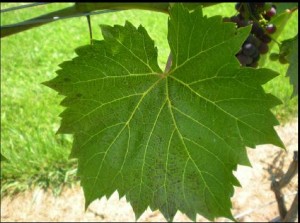Ozone Damage to Grape Leaves
This article is by Dr. Dean Volenberg of the University of Wisconsin’s Door County Extension. It was first published in the Wisconsin Grape Growers Association’s (WGGA) 30th July 2012 Vineyard IPM Scouting Report.
Ozone contains three oxygen atoms and this makes the compound very reactive to materials that it contacts. In plants, ozone enters through the stomates during gas exchange and then ozone can begin attacking plant cells. In grapes this often results in grape leaves displaying stipples (small darkly pigmented areas). The stippling on grape leaves is confined to the upper leaf surface and the symptoms typically appear on older basal leaves that are located on the exterior of the grape canopy.
In northeast Wisconsin, ozone damage on grape leaves has been observed for a number of years. Typically symptoms of ozone damage appear latter in the growing season. In Door County, ozone symptoms often appear in late August or early September.
During this time, there is abundant sunshine, and high temperatures which can lead to ozone formation. It is during these so called ‘Dog Days of Summer” of bright sunshine, high temperatures, and still air that can result in ozone injury. The level of ozone can also be increased by electrical storms. However ozone produced during electrical storms result in ozone increases in the upper atmosphere and have little impact at increasing ozone levels at the earths surface.
“Ozone damage can at times look surprisingly like advanced symptomology of potassium deficiency.”
Severe ozone injury to grape leaves can result in leaves senescing and dropping from the vine. As of yet, I have never observed severe ozone injury where leaves have dropped from the grape plant. However, this summer, we experienced a number of very sunny days with extremely above normal temperatures that may result in more ozone injury.
The symptoms of ozone injury could be confused with a disease infection or maybe a nutrient deficiency. Ozone symptoms on the leaf are very patterned and uniform. Ozone injury on the leaf results in the small leaf veins remaining green. In contrast, many grape disease infections results in chlorosis (yellowing) or necrosis (browning) of these small veins. Ozone damage can at times look surprisingly like advanced symptomology of potassium deficiency. Early symptoms of potassium deficiency are chlorotic leaf margins that progress to brown/black leaf margins. In vineyards, showing both ozone and potassium deficiency symptoms a petiole test could help confirm potassium
deficiency.
Ozone injury can also resemble another grape problem named — ‘grape blackleaf”. Blackleaf is a physiological disorder that was once thought to be the result of a potassium deficiency. Symptoms of blackleaf typically appear near veraison and like ozone the leaves on the outer canopy that are exposed to sunlight display blackleaf symptomology. The cause of blackleaf has been attributed to drought stress and UV-B radiation.
For more information on blackleaf see:
http://www.extension.org/pages/31678/blackleaf-in-grapes
[wp_geo_map]






I am curious to know if there has been any research on vine damage from ozonated water. Just met a vendor at a trade show selling an ozone sprayer for vineyard use. If the vine has damage from natural ozone would not there be much more from highly concentrated water? I don’t know the exact output of his machine but I would very concerned about using it after reading this. Any thoughts?
That’s a good question. We are preparing an article on spraying ozonated water in vineyards and we will investigate the respective levels of ozone produced by a heavy lightening storm and commercial ozone sprayers.